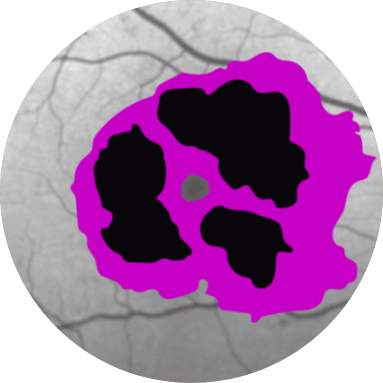Watch the video to get the facts about GA and how SYFOVRE works inside the eye
ViewHide transcript
Melanie Voice-Over:
Hi! I’m Melanie and today I’ll be your guide on a journey inside the eye. We’re going to learn about a relentless disease called Geographic Atrophy, or GA. It’s the advanced form of dry age-related macular degeneration, or AMD.
As GA progresses, it can irreversibly damage the back of the eye and cause vision loss that cannot be corrected with eyeglasses or surgery.
Since the damage caused by GA cannot be reversed, it’s important to be proactive with your eye health to slow GA.
Let’s head inside the eye to review what happens within the eye with GA and some of the warning signs.
Welcome to the eye! I imagine this is your first time here. Don’t worry, I’ll be with you every step of the way to show you around.
Have you noticed straight lines, like lamp posts, starting to appear wavy?
Distorted lines can be a symptom of GA. You may even have trouble reading, especially in low light, or driving at night. You may start to notice a blurry spot in the center of your vision that looks like a smudge or something’s missing.
Unfortunately, you can’t wipe this smudge away and as GA progresses, you may start to have trouble recognizing faces. Symptoms of GA affect everyone differently, so you need to talk to your eye doctor if you notice any changes in your vision.
Let’s go to the back of the eye and see where GA starts to form—in the retina. The retina’s job is to help your brain process what you’re seeing.
Here we see the retina, and more specifically, the macula. This is the part of your eye responsible for central vision and seeing fine detail.
With GA, your immune system gets overactivated and mistakenly starts attacking healthy cells in your retina. This can cause patches of damaged cells, called lesions, to form in or around the macula.
As the lesions damage the center of the macula, you may start to lose your central vision.
Once GA lesions start growing, there’s no turning back and the damage to your vision cannot be reversed. That’s why it’s important to know the warning signs and act now to slow GA as soon as you’re diagnosed.
This is a good time to tell you about a prescription medication used to treat GA caused by AMD, called SYFOVRE. SYFOVRE is proven to slow irreversible GA lesion growth, which can delay the progression of GA.
Here is some important safety information about SYFOVRE. Do not receive SYFOVRE if you have an infection or active swelling in or around your eye that may include pain and redness, or are allergic to it. Also, keep watching this video all the way to the end for more Important Safety Information.
SYFOVRE works by helping regulate the overactivated part of the immune system in your eye that can contribute to the progression of GA. In fact, when patients with GA were given SYFOVRE, their lesions grew slower compared to patients who were not on treatment.
If you are thinking about taking SYFOVRE, it’s important to work with your retina specialist to figure out an appropriate treatment plan you can stay committed to.
You should know that SYFOVRE must be administered regularly, and with SYFOVRE you can slow GA lesions in as few as 6 doses a year.
Starting SYFOVRE is an important first step, but staying on treatment as recommended by your retina specialist is just as important.
Your eye doctor knows a lot about this, so write down any questions you have, like: How often do I need to take SYFOVRE? Or: What should I expect? Don’t hesitate to ask them at your next appointment. Please listen to the following important safety information.
Announcer Voice-Over:
What is SYFOVRE?
SYFOVRE (pegcetacoplan injection) is a prescription eye injection, used to treat geographic atrophy (GA), the dry advanced form of age-related macular degeneration (AMD).
IMPORTANT SAFETY INFORMATION
Who should NOT receive SYFOVRE?
Do not receive SYFOVRE if you have an infection or active swelling in or around your eye that may include pain and redness, or are allergic to pegcetacoplan or any ingredients in SYFOVRE. SYFOVRE can cause serious allergic reactions such as trouble breathing, tongue, face, lips, or mouth swelling, rashes, and hives.
SYFOVRE can cause serious side effects:
- Eye infection (endophthalmitis) or separation of layers of the retina (retinal detachment)
- Call your healthcare provider right away if you have eye redness, light sensitivity, eye pain, or any change in vision including blurred, wavy/distorted vision, small specks floating in your vision, or flashing lights
- Severe inflammation of vessels in the retina which may result in severe vision loss. Call your healthcare provider right away if you have eye redness, light sensitivity, eye pain, or any change in vision including blurred, wavy/distorted vision, or flashing lights
- Risk of developing wet AMD. You should be monitored for signs of wet AMD and you should report if you have any change in vision including blurred, wavy/distorted vision, black spots, or loss of central vision to your healthcare provider
- Episodes of eye inflammation. You should report any symptoms including eye redness, light sensitivity, eye pain, small specks floating in your vision, or any changes in vision to your healthcare provider
- Increase in eye pressure within minutes of the injection. Your healthcare provider will monitor this after each injection
Before receiving SYFOVRE:
- Tell your healthcare provider if any of the following applies to you:
- If you have a history of seeing flashes of light or small specks floating in your vision and notice a sudden increase of size and number of these specks
- If you have high pressure in the eye or glaucoma
- Tell your healthcare provider about all of your medical conditions, including
- If you are, or think you are pregnant, breastfeeding, or are planning to have a baby, ask your doctor for advice before taking this medicine
- Tell your healthcare provider about all the medicines you take, including prescription and over-the-counter medicines, vitamins, and herbal supplements
What should I avoid while receiving SYFOVRE?
- After an injection or an eye exam, your eyesight may temporarily be impaired. Do not drive or use machinery until your vision recovers
What are the most common side effects of SYFOVRE?
- Eye discomfort
- Wet age-related macular degeneration
- Small specks floating in vision
- Blood in the white of the eye
These are not all the possible side effects of SYFOVRE. Tell your healthcare provider about any side effect that bothers you or does not go away.
Call your healthcare provider for medical advice about side effects. You may report side effects to the FDA at 1-800-FDA-1088 or www.fda.gov/medwatch.
Please see the SYFOVRE full Prescribing Information for more information.
Melanie Voice-Over:
I hope you’ve enjoyed going on this journey with me inside the eye. Remember, every moment counts, so act now to slow GA.
SYFOVRE is designed to slow the growth of GA lesions
It’s important to know that GA cannot be cured, and any damage cannot be reversed
Image of the retina in the back of the eye

GA lesion at diagnosis
GA lesion growth over time
Images for illustrative purposes only.
Reproduced with permission from Ruiz-Moreno et al. Fundus autofluorescence in age-related macular degeneration. AMD Book. 2017






 Back to top
Back to top